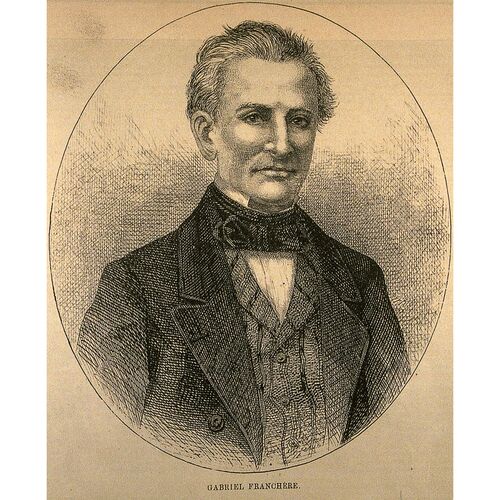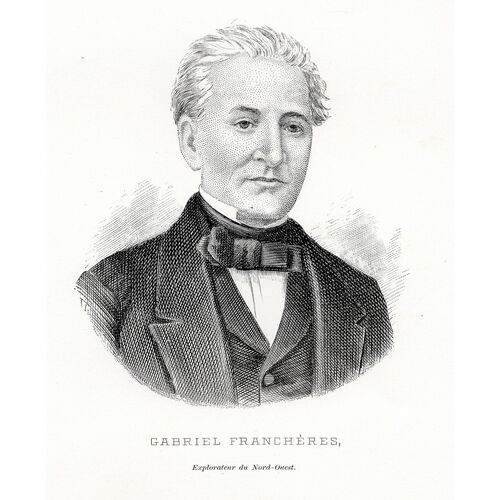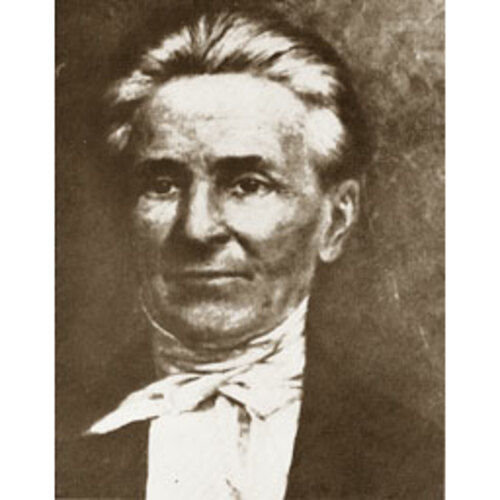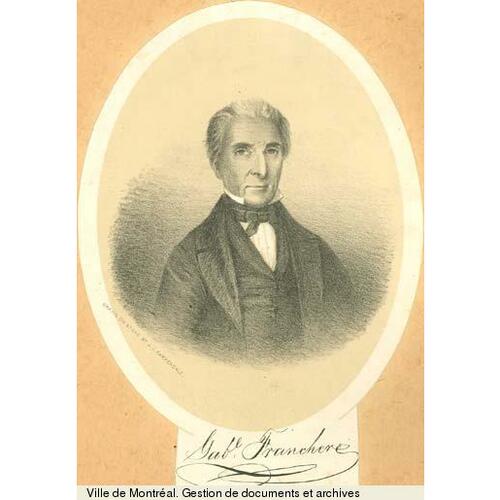FRANCHÈRE, GABRIEL, fur-trader, merchant, and author; b. 3 Nov. 1786 in Montreal, son of Gabriel Franchère, merchant, and Félicité Morin (Miron, Marin); d. 12 April 1863 in St Paul, Minn.
Gabriel Franchère’s ancestor, a ship’s surgeon, came to Quebec from France in the middle of the 18th century. His father achieved modest success in commerce, eventually became master of the port of Montreal, and was called the “dean of merchants and marguilliers” when he died in that city in May 1832. Gabriel probably had some formal education, but nothing is known of his life prior to the spring of 1810. Then, hoping to advance himself in the proposed enterprise of John Jacob Astor on the Columbia River, he signed on as clerk, one of a number of clerks and voyageurs recruited in Montreal, and set sail from New York on an adventure that determined the course of his life.
The founding of the Pacific Fur Company and the establishment of a post at the mouth of the Columbia River were part of Astor’s plan to dominate the American and perhaps the continental fur trade. The Astor empire was built upon sales and purchases of fur, tea, sandalwood, post provisions, and Indian trade goods, as well as general merchandise and shipping, and extended from the United States to both Europe and the Orient. The activities in the Pacific as well as the expanding fur trade in western North America required a fortified headquarters, which Fort Astoria would provide. The fort was established in 1811 but the prospect of hostilities after war with Britain broke out in 1812 and the aggressive competition of the North West Company forced the sale of the assets of the Pacific Fur Company to the Nor’Westers in October 1813.
Franchère, a mere clerk in Astor’s vast plan, was a member of Duncan McDougall*’s party which in 1810 made the difficult voyage around Cape Horn to the Columbia under the disturbing guidance of Captain Jonathan Thorn of the Tonquin. Franchère demonstrated his ability and common sense in the daily struggles at the outpost, observed the competition between the two companies, and finally returned to Canada with some of the survivors of the Astor enterprise in a party of Nor’Westers in 1814. But his work for the expedition was less significant than his valuable narrative of its progress, the only chronicle by one whose entire service was passed at the fort.
Franchère had kept a diary with the innocent intention of describing precisely, for family and friends, “what I had seen and learned,” and he prepared a manuscript for publication just five years after the events. This manuscript was edited by Michel Bibaud*, a respected Montreal journalist and author, who made extensive revisions and additions for its publication in 1820. The book soon became a rare and valued item in Lower Canada, and also established Franchère’s reputation as a traveller and writer. The best single account of the Astor enterprise, it became a central source for Washington Irving’s Astoria, a minor factor in the debates in the Congress of the United States over the Oregon boundary in 1846 (Franchère was invited to Washington at that time by Senator Thomas Hart Benton), and a frequently cited record of the fur trade’s relations with Indians in the era. The Oregon dispute, and the appearance of narratives of Astoria not only by Irving but also by Ross Cox* and Alexander Ross*, prompted an English translation of Franchère’s account, published in 1854. Based on Bibaud’s text, it was prepared by Jedediah Vincent Huntington, a prominent American writer, who worked with the author to clarify the perspective and increase the drama of the tale. No less than four versions of Franchère’s story have been published since, each with extensive notes and introduction.
Upon his return from the Pacific Franchère had apparently settled into the Montreal fur-trade community. On 24 April 1815 he married Sophie Routhier, the “true girl” who “was still waiting for him,” and family records suggest that he remained in the city, or near by, for the following 19 years. It is certain that he was the chief agent of the American Fur Company in Montreal from 1828 to 1834. The company enjoyed great success in these years, earning close to $200,000 in profits annually, and the Montreal office played a modest part by supplying some of the 400 to 500 engagés who laboured on Astor’s behalf for $80 to $200 per year. Franchère advertised for the trip men, travelled to several towns to enlist them, paid notaries to draw up engagements, arranged the purchase of flour and pork and spirits for the voyage to the Mackinac (Mich.) headquarters, and handled the inevitable problems of search and arrest associated with the many “deserters and delinquents” who accepted cash advances and headed for the woods.
When Astor left the fur trade in 1834, another Astorian, Ramsay Crooks*, assumed control of the American Fur Company. Franchère agreed to direct the company’s agency at Sault Ste Marie, Mich., and was thus, once again, a frontier trader and merchant. In 1842 he became the New York agent of Pierre Chouteau, Jr, and Company. He founded his own fur commission house in Brooklyn in 1857 and was probably engaged in this business at the time of his death.
His years in New York had their difficult moments, particularly after the failure of the American Fur Company in 1842 when, according to a friend, he acted “in an extremely honorable manner, [and] sacrificed his own personal fortune to assist in meeting its liabilities.” But in this era too Franchère established closer contacts with the French Canadian community on both sides of the border. He was recognized as the founder of the first American branch of the Société Saint-Jean-Baptiste, about 1850, encouraged local literary evenings, and wrote several articles for Montreal newspapers. In 1853 he was given a public welcome on a visit to Montreal and an address signed by 100 leading citizens for his work as president of the New York society.
Franchère and his wife had had eight children in their years in Montreal and Sault Ste Marie, six of whom survived childhood. When Sophie died in 1837, Franchère had been concerned about his two young daughters but a chance introduction to a widow, Charlotte Prince, in Detroit, provided a happy solution to his difficulties in 1839. Franchère was a respected member of the communities in which he lived. An appropriate comment was provided by an acquaintance, Benjamin Parke Avery of Minnesota, who described him as being “of very simple and correct habits, which insured him good health and cheerful spirits. He possessed a blithe disposition, veined with a kindly humour; was very active and intelligent, exceedingly kind-hearted, true to his adopted country, and had a firm faith in the Christian religion.”
[At least five editions of Gabriel Franchère’s journal have been published: Relation d’un voyage à la côte du Nord-Ouest de l’Amérique septentrionale, dans les années 1810, II, 12, 13 et 14, Michel Bibaud, édit. (Montréal, 1820); Narrative of a voyage to the northwest coast of America in the years 1811,1812,1813, and 1814; or, the first American settlement on the Pacific, ed. and trans. J. V. Huntington (New York, 1854) (repr. in Early western travels, 1748–1846; a series of annotated reprints of some of the best and rarest contemporary volumes of travel . . . , ed. R. G. Thwaites (32v., Cleveland, Ohio, 1904–7)), VI; A voyage to the northwest coast of America, ed. M. M. Quaife (Chicago, 1954); Journal of a voyage (Lamb); Adventure at Astoria, 1810–1814, ed. And trans. H. C. Franchère (Norman, Okla., 1967).
A number of American archives hold material on Franchère: Bayliss Public Library (Saint Ste Marie, Mich.), documents on the American Fur Company and letters of Franchère from 1834 to 1840; Clarke Historical Library (Central Michigan University, Mount Pleasant), Franchère papers, 18340, J. R. Livingston papers, 18328, in the Sault Ste Marie toll.; Detroit Public Library, Burton Hist. Coll.; Minn. Hist. Soc. (St Paul), Franchère papers and H. H. Sibley papers; Mo. Hist. Soc. (St Louis), American Fur Company papers, 1802–58; N.Y. Hist. Soc., American Fur Company papers. g.f.]
PAC, MG 19, B2, 1–6. [Washington Irving], Astoria; or, anecdotes of an enterprise beyond the Rocky Mountains, ed. E. W. Todd (Norman, Okla., 1964). “Une lettre au chirurgien Jacques Franchère,” É.-Z. Massicotte, édit., BRH, XXXVII (1931), 348–51. La Minerve, 5 mai 1863. New York Times, 15 April 1863. [F.-M.-U.-]M. Bibaud, Le panthéon canadien; choix de biographies, dans lequel on a introduit les hommes les plus célèbres des autres colonies britanniques (2e éd., Montréal, 1891), 100. Tassé, Les Canadiens de l’Ouest, I, II. Alexandre Belisle, Histoire de la presse franco-américaine; comprenant l’historique de l’émigration des Canadiens-français aux États-Unis, leur développement, et leurs progrès (Worcester, Mass., 1911), 12, 45, 432. K. W. Porter, John Jacob Astor, business man (2v., Cambridge, Mass., 1931; repr., New York, 1966), II, 819, 830–32. F.-J. Audet, “En marge d’un centenaire: André Jobin, Benjamin Holmes, Gabriel Franchère, régisseurs,” La Presse (Montréal), 23 déc. 1933. B. P. Avery, “Death of a remarkable man,” Minn. Hist. Soc., Coll. (St Paul), VI (1894), 417–20.
Cite This Article
Gerald Friesen, “FRANCHÈRE, GABRIEL,” in Dictionary of Canadian Biography, vol. 9, University of Toronto/Université Laval, 2003–, accessed December 22, 2025, https://www.biographi.ca/en/bio/franchere_gabriel_9E.html.
The citation above shows the format for footnotes and endnotes according to the Chicago manual of style (16th edition). Information to be used in other citation formats:
| Permalink: | https://www.biographi.ca/en/bio/franchere_gabriel_9E.html |
| Author of Article: | Gerald Friesen |
| Title of Article: | FRANCHÈRE, GABRIEL |
| Publication Name: | Dictionary of Canadian Biography, vol. 9 |
| Publisher: | University of Toronto/Université Laval |
| Year of publication: | 1976 |
| Year of revision: | 1976 |
| Access Date: | December 22, 2025 |


![Gabriel Franchères [sic]. Explorateur du Nord-Ouest [image fixe] Original title: Gabriel Franchères [sic]. Explorateur du Nord-Ouest [image fixe]](/bioimages/w600.3862.jpg)




